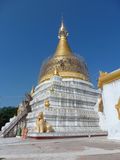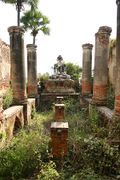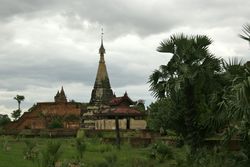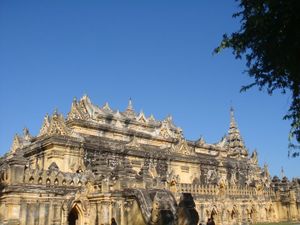إنوا
| ||||||||||||||||||||||||
إنوا Inwa أو آڤا (Ava ؛ بالبورمية: အင်းဝမြို့; MLCTS: ang:wa.mrui.؛ IPA: [ʔɪ́ɴwa̰ mjo̰] أو [ʔəwa̰ mjo̰]، وتُكتب أيضاً Innwa)، تقع في Mandalay Region، بورما (ميانمار)، هي عاصمة امبراطورية قديمة لعدد من الممالك البورمية المتعاقبة من القرن الرابع عشر حتى القرن التاسع عشر. وعلى مر التاريخ، فقد دُمـِّرت المدينة وأعيد بناؤها عدة مرات. وفي النهاية هـُجـِرت تلك العاصمة بعد الدمار الشامل الذي سببته سلسلة من الزلازل الكبيرة في مارس 1839. وبالرغم من أن قليلاً من آثار المجد الغابر قد بقيت ليومنا هذا، إلا أن العاصمة السابقة هي مقصد سياحي شهير لرحلات نفس اليوم من مندلاي.
أصل الاسم
الاسم إنوا (အင်းဝ) يعني حرفياً "فم البحيرة"، عاكساً موقعها الجغرافي على فم بحيرات في Kyaukse District. وثمة نظرية أخرى تقول أن الاسم مشتق من إنـّاوا (အင်းနဝ)، ويعني "البحيرات التسع" في المنطقة.[1] الاسم الكلاسيكي للمدينة بلغة پالي هو رَتاناپورا (ရတနပုရ; "مدينة الجواهر").[2][3]
النطق بالبورمية الفصحى الحديثة هو إنوا (IPA: [ʔɪ́ɴwa̰]), following the modern orthography. But the local Upper Burmese pronunciation is Awa ([ʔəwa̰]). Indeed, the spelling of the city in the royal records, all written prior to the modern Burmese spelling standardization drives, is အဝ (Awa), the phonetic spelling of the Upper Burmese usage.[4] The most common Western transcription Ava comes from Awa via Portuguese.
التاريخ
كانت إنوا عاصمة بورما لنحو 360 سنة، على خمس فترات منفصلة، من 1365 إلى 1842. ولذلك عُرفت كمقر السلطة في بورما حتى أن إنوا (كمملكة آڤا، أو بلاط آڤا) كانت الاسم الذي تُعرف به بورما لدى الأوروپيين حتى القرن 19.
التأسيس
Strategically located on the confluence of Irrawaddy, and Myitnge rivers, and in the main rice-growing Kyaukse District of Upper Burma, the location of Ava had been scouted as a possible capital site as early as 1310 by King Thihathu. Though Thihathu eventually built his new capital at Pinya a few miles east inland in 1313, Thihathu's great-grandson Thado Minbya, who unified the Sagaing and Pinya kingdoms in September 1364, chose the site of Inwa as his new capital.
Inwa was officially founded on 26 February 1365 (6th waxing of Tabaung 726 ME)[5] on a man-made island created by connecting the Irrawaddy on the north and the Myitnge on the east with a canal on the south and the west. The construction of the artificial island also involved filling in the swamplands and lakes (or Ins):[1]†
- Shwekyabin In (ရွှေကြာပင် အင်း)
- Zani In (ဇနီ အင်း)
- Nyaungzauk In (ညောင်စောက် အင်း)
- Wetchi In (ဝက်ချေး အင်း)
- Ohnne In (အုန္နဲ အင်း)
- Inma In (အင်းမ အင်း)
- Linsan In (လင်းစံ အင်း)
- Bayme In (ဘေးမဲ့ အင်း)
- Wunbe In (ဝမ်းဘဲ အင်း)
† Other records also include Kyaukmaw In (ကျောက်မော် အင်း), Ngagyi In (ငကျည်း အင်း) and Inbu In (အင်းဘူး အင်း).
The brick fortifications of Inwa do not follow the conventions of the earlier rectilinear city plans. Instead, the zigzagged outer walls are popularly thought to outline the figure of a seated lion. The inner enclosure or citadel was laid out according to traditional cosmological principles and provided the requisite twelve gates. (The inner city was reconstructed on at least three occasions in 1597, 1763, and 1832.)[6]
فترة آڤا (القرون 14 إلى 16)
The kingdom Thado Minbya founded with the capital at Inwa became known as the Ava Kingdom, the main polity of Upper Burma until 1555. During this period, the city was the center of a flourishing literary scene in which Burmese literature "grew more confident, popular, and stylistically diverse, chiefly through the efforts of monks who chose to write in the vernacular rather than, or in addition to, in Pali."[7] The period also saw the second generation of Burmese law codes (dhammathats), which critiqued earlier compilations, new poetic genres, and the perfection of older verse forms as well as the earliest pan-Burma Burmese language chronicles.[7] The city got a new "exquisite golden palace" in February 1511 by which King Shwenankyawshin is posthumously remembered.[8]
During this period, the capital city was the target of the kingdom's rivals. It came under siege in 1404–1405 during the Forty Years' War. Over a century later, on 25 March 1527, the city finally fell to the repeated attacks by the Confederation of Shan States and the Prome Kingdom.[9] It then became the capital of the unruly and often disunited coalition until 22 January 1555 when it was captured by King Bayinnaung. The city's 190-year run as the capital of Upper Burma came to an end.
فترتا تونگو و Konbaung (القرون 16-19)
The city became the capital of all Burma during Toungoo and Konbaung periods (1599–1613, 1635–1752, 1765–1783, 1821–1842). The city was the base from which kings Nyaungyan and Anaukpetlun restored the kingdom which had temporarily disintegrated in December 1599. In January 1635, King Thalun moved the capital back to Ava from Pegu (Bago).[10] The city was sacked on 21–23 March 1752, and subsequently burned down on 3 January 1753 by the forces of Restored Hanthawaddy Kingdom. King Hsinbyushin began the reconstruction of the city in March 1764, and moved the capital back to a newly rebuilt Ava on 23 July 1765.[11] King Bodawpaya moved the capital to Amarapura in May 1783 but his grandson King Bagyidaw moved it back to Ava in November 1821.
النهاية
The end of the city came via a natural disaster. Starting on 22 March 1839 (7th waxing of Tagu 1201 ME) the Inwa–Amapura region was hit by a series of earthquakes. The main earthquake hit the region, as far west as Sagaing, the next day, at five o'clock in the morning on 23 March 1839, and many tremors followed for days afterwards. The entire region was left in shambles in their wake. The capital was hardest hit: everything was leveled; many people and livestock perished.[12] The city was not rebuilt. King Tharrawaddy chose instead to rebuild a new palace in Amarapura, and moved the seat of his government there in February 1842.[13]
إنوا الحالية
The former capital city site is a popular tourist day-trip destination from Mandalay. Tourists can still observe a few remnants of the capital, including Nanmadaw Me Nu Ok Kyaung, the Nanmyin Tower, the inner and outer brick city walls, etc.
المعالم
| الاسم | الصورة | بُني | الراعي | ملاحظات |
|---|---|---|---|---|
| جسر آڤا | 
|
1934 | The British | This 16 span cantilever bridge was the only structure to span the Irrawaddy until recently. Although now superseded by a parallel 2005 road bridge, it is still in use for railway and local road traffic. |
| موقع قصر آڤا | 
|
1821 | الملك Bagyidaw | The site of the deserted Palace of Ava is now marked by a solitary masonry 27 متر (89 ft) high watchtower, an example of early 19th century Burmese architecture.[14] It is all that remains of the stately Palace reared by King Bagyidaw.[14] |
| Bagaya Monastery | 
|
1770s | Maha Thiri Zeya Thinkhaya | "Monastic college" where the royals were educated |
| Htihlaing Shin Pagoda | ستوپا بناها الملك Kyansittha من أسرة پگان (أواخر القرن 11) | |||
| Judson Memorial | A stone that marks the site of Let Ma Yun (lit. "no pulling punches") prison where the American missionary Adoniram Judson was incarcerated during the First Anglo-Burmese War (1824–26) | |||
| Lawka Tharahpu Pagoda | 
|
|||
| Maha Aungmye Bonzan Monastery | 
|
1822 | Queen Me Nu | Popularly known as Me Nu Ok Kyaung (lit. "Me Nu's Brick Monastery"), it was built in 1818 by Nanmadaw Me Nu, the famous Chief Queen of Bagyidaw, for the residence of her religious Preceptor, the Nyaunggan Sayadaw.[14] The earthquake of 1838, damaged it, and in 1873, it was restored by Sinbyumashin, Queen of Mindon, and a daughter of Nanmadaw Me Nu.[14] The building is markedly different from traditional Burmese monasteries, which are constructed with wood, not masonry. |
| Yadana Hsimi Pagodas | 
|
أطلال مجموعة من الستوپات (بسبب زلازل 1839) |
النقل
Inwa is located 21 كيلومتر (13 mi) south of Mandalay. It is on the way from the Mandalay International Airport to Mandalay. Cars can go up to the Myitnge river. It takes a 3-minute boat ride to cross over to the former capital site. On the Inwa side, a number of horse-drawn carts await the tourist business.
معرض صور
الهامش
- ^ أ ب Khin Khin Aye 2007: 60
- ^ ဦးဟုတ်စိန်. "Entry for ratana". ပါဠိမြန်မာ အဘိဓာန် (Pāḷi-Myanmar Dictionary) (in Burmese). Pali Canon E-Dictionary Version 1.94. Retrieved 15 February 2015.
{{cite web}}: CS1 maint: unrecognized language (link) - ^ ဦးဟုတ်စိန်. "Entry for pura". ပါဠိမြန်မာ အဘိဓာန် (Pāḷi-Myanmar Dictionary) (in Burmese). Pali Canon E-Dictionary Version 1.94. Retrieved 15 February 2015.
{{cite web}}: CS1 maint: unrecognized language (link) - ^ See Hmannan Yazawin, for example.
- ^ Hmannan Vol. 1 2003: 396
- ^ Cooler 2003: Chapter 4, Part 1
- ^ أ ب Lieberman 2003: 134
- ^ Khin Khin Aye 2007: 61
- ^ Hmannan Vol. 2 2003: 137
- ^ Hmannan Vol. 3 2003: 223
- ^ Maung Maung Tin Vol. 1 2004: 278
- ^ Maung Maung Tin Vol. 2 2004: 394
- ^ Maung Maung Tin Vol. 3 2004: 33
- ^ أ ب ت ث Report 1907, p. 16.
مراجع
- Report of the Superintendent, Archaeological Survey, Burma. Rangoon: Office of the Superintendent, Government Printing, Burma. 1907.
- Royal Historical Commission of Burma (1829–1832). Hmannan Yazawin (in Burmese). Vol. 1–3 (2003 ed.). Yangon: Ministry of Information, Myanmar.
{{cite book}}: CS1 maint: unrecognized language (link) - Cooler, Richard M. (2002). "The Post Pagan Period - 14th To 20th Centuries -- Part I". Northern Illinois University.
- Khin Khin Aye (January 2007). "Inscription record of Shwenankyawshin Narapati's Ava Palace construction". Myanmar Vista Research Magazine (in Burmese). Yangon. 1 (1).
{{cite journal}}: CS1 maint: unrecognized language (link) - Lieberman, Victor B. (2003). Strange Parallels: Southeast Asia in Global Context, c. 800–1830, volume 1, Integration on the Mainland. Cambridge University Press. ISBN 978-0-521-80496-7.
- Maung Maung Tin, U (1905). Konbaung Hset Maha Yazawin (in Burmese). Vol. 1–3 (2004 ed.). Yangon: Department of Universities History Research, University of Yangon.
{{cite book}}: CS1 maint: unrecognized language (link)
وصلات خارجية
- Inwa - a short story by Theippan Maung Wa 1931 inc. audio
- Exploring old monasteries in ancient capital Inwa
إنوا
| ||
| سبقه Pinya |
عاصمة مملكة آڤا 26 فبراير 1365 – 22 يناير 1555 |
تبعه Pegu |
| سبقه Pegu |
عاصمة بورما 19 December 1599 – 14 May 1613 |
تبعه Pegu |
| سبقه Pegu |
عاصمة بورما 25 January 1635 – 23 March 1752 |
تبعه Shwebo |
| سبقه Sagaing |
عاصمة بورما 23 July 1765 – 13 May 1783 |
تبعه أماراپورا |
| سبقه أماراپورا |
عاصمة بورما 22 نوفمبر 1821 – 10 فبراير 1842 |
تبعه أماراپورا |


















